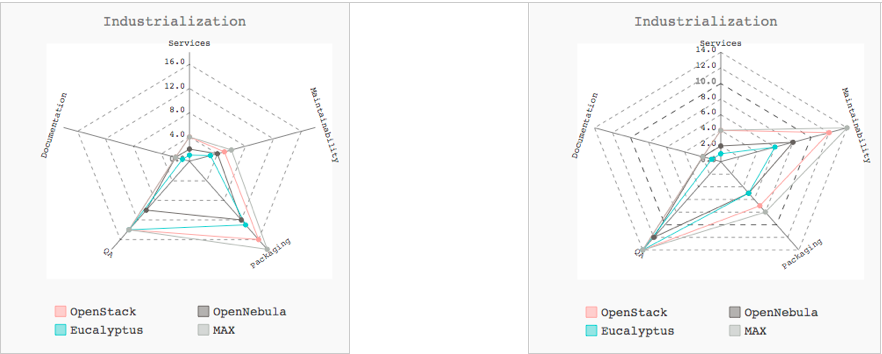Open Source Clouds Comparison: Eucalyptus, OpeNebula and OpenStack
(Author: Davide Galletti) OSSEval (formerly SOS Open Source) has been used to analyze three different open source cloud solutions, namely Eucalyptus, OpenNebula and OpenStack, respectively maintained by the homonymous US-based company Eucalyptus recently acquired by HP, the Spanish C12G Labs company and the North-American OpenStack Foundation.
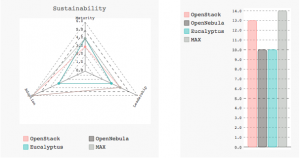 All these projects were created over 3 years ago, OpenNebula was started actually 9 years ago. All projects’ code base result mature and stable. While there are few books about OpenStack and some are also available about OpenNebula, there is no book about Eucalyptus.
All these projects were created over 3 years ago, OpenNebula was started actually 9 years ago. All projects’ code base result mature and stable. While there are few books about OpenStack and some are also available about OpenNebula, there is no book about Eucalyptus.
This is an area where Eucalyptus could work out a way to get a book published, either by investing some time or money to get it done. Both Eucalyptus and OpenStack have few case studies available, but considering they are both leveraging an ecosystem of partners they would just need to ask them to publish some case studies, eventually offering to promote those via their sites or marketplaces.
OpenStack popularity is definitely higher than Eucalyptus, then it turn it’s more visible than OpenNebula. While OpenStack popularity is the result of a strong commitment from a number of vendors and players, plus the existence of a dedicated foundation, both Eucalyptus and OpenNebula could do a better job to promote their projects. Opening ad hoc Linkedin groups as well as being vocal on cloud-related Linkedin groups could be a start. A more active presence on all social media, especially FaceBook and Twitter is also recommended.
All these projects are backed by a team of 10+ developers.
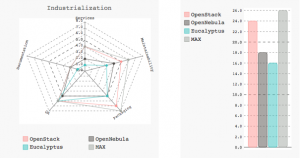 All projects are solid in terms of industrialization. Documentation is available in few languages for both OpenNebula and OpenStack, while it is English-centric for Eucalyptus. Eucalyptus could definitely engage with its own world-wide partners to motivate them to create some documentation.
All projects are solid in terms of industrialization. Documentation is available in few languages for both OpenNebula and OpenStack, while it is English-centric for Eucalyptus. Eucalyptus could definitely engage with its own world-wide partners to motivate them to create some documentation.
Probably the biggest difference is about Training and Commercial Support. OpenStack is supported by many different vendors in many countries, also Eucalyptus provides a list of local partners around the world. OpenNebula offer a more limited support while its community provides some support. This is an area where OpenNebula could definitely do more, possibly by offering tools and documentation to ISVs or even by creating a program for VARs.
All code base are well commented and developed in a main language, QA is a well established and managed process for both Eucalyptus and OpenStack, but it’s a little less solid for OpenNebula. Not sure this could be easily fixed, all in all it would require more effort and this likely depends on the size of their customer base.
All solutions are supported in a number of OS and easy to test – since virtual appliances are available – OpenStack is the winner for easiness and variety of choice.
Projects Strategy.
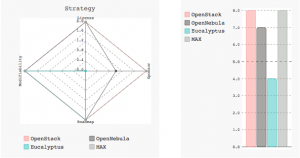 As a general rule there is a clear difference between fully community-led projects and vendor-led projects, especially in terms of IP management and sharing control. For example the Eucalyptus decision to go GPL makes asymmetrical the benefit of joining a similar project for other vendors. as seen with MySQL and other open source projects before. But licensing is just one thing, how easy or difficult is to influence the product roadmap or the way a community works are even more important aspects.
As a general rule there is a clear difference between fully community-led projects and vendor-led projects, especially in terms of IP management and sharing control. For example the Eucalyptus decision to go GPL makes asymmetrical the benefit of joining a similar project for other vendors. as seen with MySQL and other open source projects before. But licensing is just one thing, how easy or difficult is to influence the product roadmap or the way a community works are even more important aspects.
While all these projects are deployed keeping in mind the importance of having ‘external’ contributors, there are not negligible differences on how such a ‘sharing strategy’ is deployed. Looking at how those three projects manage blueprints is interesting. Eucalyptus has the typical vendor approach: it is the company and only the company to take decisions in this sense. OpenNebula is a bit more open and allows third parties to sponsor a given feature request. OpenStack leads the sharing model. In fact they manage a 6 months release cycle by organizing a Design Summit where the community gathers and assemble the roadmap. Moreover more recently they launched a marketplace, allowing all parties to promote their add-ons and services.
Comparing Borrow and Share scenarios
We have been analyzing these three projects using weights that reflect the different needs of ‘borrowers’ – people downloading software and reusing it „as is“ – and shareholders – people willing to enhance the original code base and willing to give it back to the community.
Looking at the Sustainability charts it appears that Borrowers are more focused on differences about Adoption, while shareholders look at the different Leadership. The explanation of this is that the level of Adoption matters to whom is looking for an off-the-shelf open source product, while the type of community (monarchy, vendor-led, community-led) affect the levels of participation that is possible to achieve.
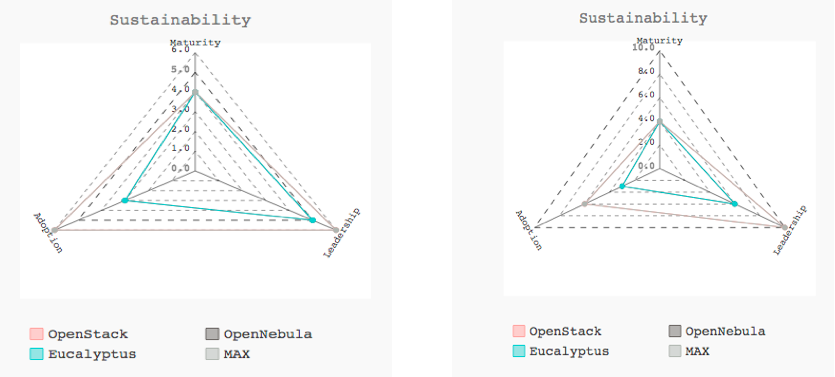 Looking at how those projects are showing in the Industrialization charts, we can see other differences.
Looking at how those projects are showing in the Industrialization charts, we can see other differences.
Both available Services and Packaging are more important for Borrowers, where shareholders are more focused on Maintainability. In fact Borrowers want to be able to buy services and get it for their favorite platform, where Shareholders want to be able to read and maintain the code base.
The last comparison shows how important is the sponsorship for shareholders.
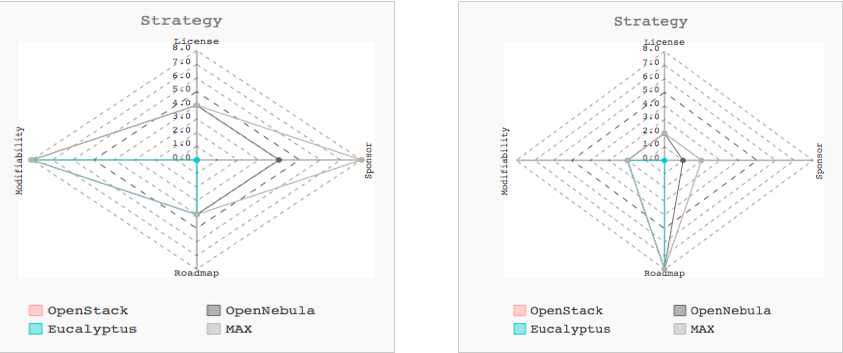 In fact for ISVs or vendors willing to invest in a platform and go beyond borrowing to sharing enhancements and advancements, community-led are their first best. If community management is clear and how to manage issues is well outlined, joining an existing project presents limited barriers to enter (acquiring knowledge).
In fact for ISVs or vendors willing to invest in a platform and go beyond borrowing to sharing enhancements and advancements, community-led are their first best. If community management is clear and how to manage issues is well outlined, joining an existing project presents limited barriers to enter (acquiring knowledge).
All open source cloud solutions resulted an open source professional platform, but some like OpenStack might be suited for organizations, system integrators and whoever else want to embrace and extend the existing code base. Eucalyptus would be good for borrowers or channel partners, that receive support and directions. We would probably not recommended other organization to use it without direct support from the vendor or one of their partners. OpenNebula could be good enough for VARs and resellers if C12G would eventually create a partnership program for VARs, typically interested in distributing a program ‘as is’. As of now only C12G customers could probably benefit from the platform.
If you read this all and you feel like you want to know more about these open source cloud platforms, you can still watch the quantitative state of the Open Cloud video and learn more from the voice of Jesus Barahona. In his OSCON presentation he provides a lot of interesting insights collected by analyzing the data obtained from their respective developing repositories using the Grimoire technology.


